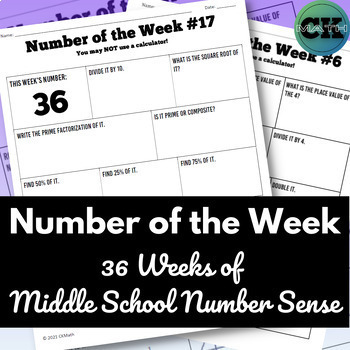Number of the Week - 36 Weeks of Middle School Number Sense and Mental Math
- PDF
What educators are saying
Also included in
- Help increase your students' fluency with number sense and solving equations with this weekly math practice and spiral review! This bundle includes two sets of weekly math practice - one to increase mental math and number sense skills, and the other to build equation solving skills. Students are giPrice $15.00Original Price $18.50Save $3.50
Description
Are your students reaching for a calculator for simple problems? This is an excellent solution for math intervention or any class that needs work on basic math skills! Weekly practice and spiral review will boost your students' mental math, number sense skills, and confidence in working with numbers through practice and repetition. Includes 36 worksheets - one worksheet for each week of the school year.
I created this resource for my middle school math intervention and remediation students after finding that they struggled with basic number sense and were always reaching for a calculator. After searching for resources to build their number sense skills, I found that most activities available are geared toward elementary students. This activity builds number sense and confidence in working with numbers in middle school students. This activity would work well as a weekly assignment in a traditional math class, resource math classes, or intervention groups.
The 36 Number of the Week worksheets include positive numbers, negative numbers, decimals, fractions, and percents.
Students are asked to perform a variety of tasks with each number, including:
- Identifying Place Value
- Halving, Doubling, Tripling
- Comparing Numbers
- Finding Factors and Multiples
- Finding Fraction and Decimal Equivalents
- Finding Basic Percents of Numbers
- Finding Fractional Parts of Numbers
- Multiplying and Dividing by Ten
- Placing Numbers on a Number Line
- Finding Common Factors
- Prime Factorization
- Ordering Rational Numbers
- Classifying Numbers as Rational/Irrational, Integers, or Whole Numbers
- Writing One-Step Equations
- Writing Number Sentences
- AND More!
Other Resources that might interest you:
Equation of the Week - 36 Weeks of Solving Equations Practice!
Adding and Subtracting Integers Two Truths and Lie - Digital + Paper Activities!
Statistics Data Comparison Project - Middle School Math or Algebra 1 (Editable!)






